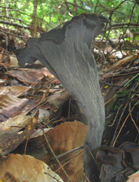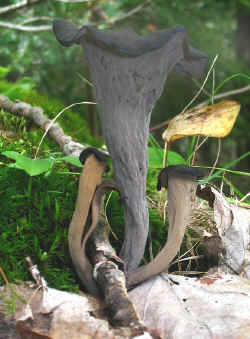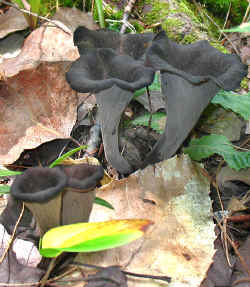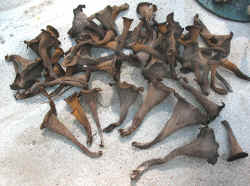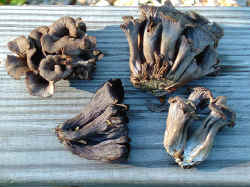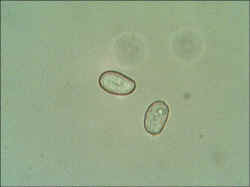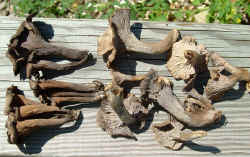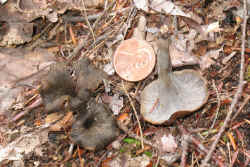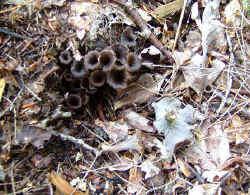|
|
A New England and Eastern Canada Edible and Medicinal Mushroom Resource |
||
|
Black Trumpet
Over the years that I have collected mushrooms I mostly made my own way not joining clubs or forays. I barely knew they existed. In the 70s and 80s I stayed pretty conservative in my approach to collecting only adding a species to my edible list once or twice a year. Occasionally I saw a few black trumpets but did not pick or eat them. A few years back when I first tried them I realized I had been missing possibly the best tasting mushroom of all. When I first started looking for them I found nothing. There are actually very few in my immediate area. It was not until this past year when the flood gates broke and I learned how to find a lot. I also learned that there are at least four distinct types of "trumpets" in this area. It's all about seeing. My collecting style worked fine for chanterelles and other more obvious mushrooms because I was always trying to see from a distance rather than looking straight down. I was always spotting trees from a distance. This will not work for finding black trumpets. They cannot be spotted from a distance. I was hunting the wrong way. The various trumpets are all funnel shaped and gray, brown, or black often growing in small bunches and occasionally singly and range in height from 1-6 inches. Cap (pileus) 3/4 - 3 inches across with very thin flesh. Gray, brown or black with a flower-like appearance except for C. foetidus which has a flatter, thicker, gray, more chanterelle-like cap. All have an very strong perfume-like aroma. Very fragrant. These smell stronger (in a good way) than any other type of mushroom I find. Gills are not present in Craterellus cornucopioides. The surface will be smooth or have just the slightest hint of ridges and be black, brown, or rust color. Craterellus foetidus and Craterellus cenerius have shallow gray gill ridges. Stem (stipe) Hollow in all types and very thin except for Craterellus foetidus has a thicker somewhat meaty stem. Flesh Gray, brown, or black and very thin. Craterellus foetidus has slightly thicker gray flesh. Spores from white to rust color. When and where to find them (ecology) Jerry Goguen from MA came to Maine last year and we walked out in the woods of Hallowell. I got lessons. He explained to me about "washes". Washes are intermittent streams on hills, small mountains and in valleys where water rushes through during spring runoff and heavy rainstorms. Sometimes the water creates natural "dams" of dead trees or branches that fall and are washed down the hill and lodge sideways behind living trees. A stone wall can also be a "dam". Mushrooms like black trumpets and chanterelles tend to proliferate in washes below these "dams" especially in the presence of moss, beeches, and mixed woods. Washes can often be followed long distances with phenomenal results (bring your GPS). Shady is better. Once I got the idea of washes, black trumpets seemed to be everywhere. We found a lot that day. You have to be looking directly down. When I was out with Jerry in the woods I eventually needed to relieve myself and went behind a tree. I looked down. There were trumpets all around me! Dang, got to find another tree! Trumpets like the beeches and oaks around here and they like growing on hummocks underneath them or nearby. They look like brown, black, or gray pansies growing in leaves and other natural camouflage so noticing your surroundings is important but you have to be looking down. Trumpets tend to grow in the same places year after year. I found quite a few large patches to return to next year. I can hardly wait. These come in late June and continue through the summer. Beeches, mixed woods and low, shady, damp locations such as ponds and swamps are good places to look. I found a very small variety under hemlock. They seemed to have slightly less taste than the other types but were still very good. All four types I have found were delicious. Preparation These are the top of the line. Trumpets need to be very carefully cleaned. Their trumpet shape may capture quite a bit of sand, dirt, or other vegetable matter. Sometimes splitting them in half is best. You can easily do this by gently pulling at opposite sides of the cap. They are great sautéed, tempura fried or dried. A thin batter is best when tempura frying. I think they are best plainly prepared or in a recipe that showcases trumpet flavor. They should be tasted plainly cooked before deciding where to go recipe-wise. Anyone putting these in a big mix with other mushrooms, especially agaricus sp., or Boletus edulis should get the electric chair! That said, there are actually a lot of ways to use them. They can be mixed and matched with most foods you would associate with white wine. A mix of various Craterellus and Cantharellus species (chanterelles and trumpets) is good because they have similar flavor characteristics. Milder flavored wild species like shaggy mane, chicken of the woods or the similar flavored hedgehogs will mix well. Seafood, chicken, veal, pork, rice, pasta, cheese and certain sauces, will be good with trumpets. Mycologist Greg Marley made a black trumpet white pizza for the Maine Mycological Assoc. annual meeting that was some of the best pizza eating ever. Author and mushroom expert David Fischer of AmericanMushrooms.com suggests using trumpets to flavor white wine. I tried it putting some dried fruit bodies in the wine and letting it sit for a few days. It was great. The trumpet character came to the fore when the wine warmed up a bit. I emailed him to say it was his fault I was half in the bag. Fortunately he appreciated my humor. The chardonnay I first tried may have been a bit on the "big" side flavor-wise. I tried inexpensive sauvignon blanc and discovered that trumpets can only help cheap wine so much. This is a drawing board I can definitely go back to! Comments As always, just try a little if it is your first time. Recent DNA studies suggest that Craterellus cornucopioides and Craterellus fallax are the same mushroom even though they have slightly different looks and spore print colors. Hopefully, DNA analysis will sort out some of the taxonomic mess we have with this and other groups. Maybe it will generate even more confusion. Who knows? People can wrangle over which is which but I take it in stride and have eaten all types without incident. Every type of Craterellus I have tried has been absolutely great. Find more information here: The
Cantharellus/Craterellus Clade at MushroomExpert.com If you like my photography, I have products like tee
shirts, aprons, coffee cups, and other items
available here.
Use of this site will constitute
your acceptance of the disclaimer. Copyright
2011 Mushroom-Collecting.com. All rights
reserved. |
